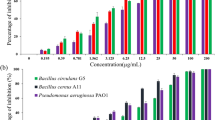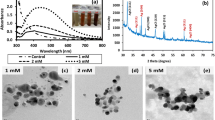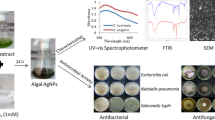Abstract
Numerous bacteria, fungi, yeasts and viruses have been exploited for biosynthesis of highly structured metal sulfide and metallic nanoparticles. Haloarchaea (salt-loving archaea) of the third domain of life Archaea, on the other hand have not yet been explored for nanoparticle synthesis. In this study, we report the intracellular synthesis of stable, mostly spherical silver nanoparticles (AgNPs) by the haloarchaeal isolate Halococcus salifodinae BK3. The culture on adaptation to silver nitrate exhibited growth kinetics similar to that of the control. NADH-dependent nitrate reductase was involved in silver tolerance, reduction, synthesis of AgNPs, and exhibited metal-dependent increase in enzyme activity. The AgNPs preparation was characterized using UV–visible spectroscopy, XRD, TEM and EDAX. The XRD analysis of the nanoparticles showed the characteristic Bragg peaks of face-centered cubic silver with crystallite domain size of 22 and 12 nm for AgNPs synthesized in NTYE and halophilic nitrate broth (HNB), respectively. The average particle size obtained from TEM analysis was 50.3 and 12 nm for AgNPs synthesized in NTYE and HNB, respectively. This is the first report on the synthesis of silver nanoparticles by haloarchaea.







Similar content being viewed by others
Abbreviations
- NTYE:
-
NaCl, tryptone, yeast extract
- AgNPs:
-
Silver nanoparticles
- MNPs:
-
Metallic nanoparticles
- HNB:
-
Halophilic nitrate broth
- XRD:
-
X-ray diffraction
- TEM:
-
Transmission electron microscopy
- EDAX:
-
Energy dispersive x-ray analysis
- SAED:
-
Selected area electron diffraction
- NR:
-
Nitrate reductase
- fcc:
-
Face-centered cubic
- EDTA:
-
Ethylene diamine tetra acetic acid
- PMSF:
-
Phenyl methane sulfonyl fluoride
- IAA:
-
Iodoacetate
- NED:
-
N-(1-Naphthyl) ethylene diamine hydrochloride
- DTNB:
-
5,5′-Dithio-bis (2-nitrobenzoic acid)
- T-SH:
-
Total thiol
- NP-SH:
-
Non-protein thiol
- PB-SH:
-
Protein-bound thiol
- CFE:
-
Cell-free extract
- ZoI:
-
Zone of inhibition
- GSH:
-
Glutathione
- γGC:
-
Gamma glutamyl cysteine
- GCR:
-
bis-γ-Glutamyl cysteine reductase
- MTP:
-
Multiply-twinned particles
References
Ahmad A, Mukherjee P, Senapati S, Mandal D, Khan MI, Kumar R (2003) Extracellular biosynthesis of silver nanoparticles using the fungus Fusarium oxysporum. Colloids Surf B 28:313–318
Avery SV (2001) Metal toxicity in yeast and the role of oxidative stress. Adv Appl Microbiol 49:111–142
Babu MMG, Sridhar J, Gunasekaran P (2011) Global transcriptome analysis of Bacillus cereus ATCC 14579 in response to silver nitrate stress. J Nanobiotechnol 9:49. doi:10.1186/1477-3155-9-49
Bai HJ, Zhang ZM, Guo Y, Yang GE (2009) Biosynthesis of cadmium sulfide nanoparticles by photosynthetic bacteria Rhodopseudomonas palustris. Colloids Surf B 70:142–146
Basavaraja S, Balaji SD, Lagashetty A, Rajasab AH, Venkataraman A (2008) Extracellular biosynthesis of silver nanoparticles using the fungus Fusarium semitectum. Mater Res Bull 43:1164–1170
Berney M, Weilenmann HU, Ihssen J, Bassin C, Egli T (2006) Specific growth rate determines the sensitivity of Escherichia coli to thermal, UVA, and solar disinfection. Appl Environ Microbiol 72:2586–2593
Borrelly GPM, Harrison MD, Robinson AK, Cox SG, Robinson NJ, Whitehall SK (2002) Surplus zinc is handled by Zym1 metallothionein and Zhf endoplasmic reticulum transporter in Schizosaccharomyces pombe. J Biol Chem 277:30394–30400
Breidt F, Romick TL, Fleming HF (1994) Rapid method for the determination of bacterial growth kinetics. J Rapid Methods Autom Microbiol 3:59–68
Catauro M, Raucci MG, De Gaetano F, Marotta A (2004) Antibacterial and bioactive silver-containing Na2O × CaO × SiO2 glass prepared by sol-gel method. J Mater Sci Mater Med 15:831–837
Danilcauk M, Lund A, Saldo J, Yamada H, Michalik J (2006) Conduction electron spin resonance of small silver particles. Spectrochimaca Acta Part A 63:189–191
Deepak V, Kalishwaralal K, Ram Kumar Pandian S, Gurunathan S (2011) An insight into the bacterial biogenesis of silver nanoparticles, industrial production and scale-up. In: Rai M, Durán N (eds) Metal nanoparticles in microbiology. Springer, Berlin, pp 17–35
Durán N, Marcato PD, Alves O, Souza G (2005) Mechanistic aspects of biosynthesis of silver nanoparticles by several Fusarium oxysporum strains. J Nanobiotechnol 3:8. doi:10.1186/1477-3155-3-8
Fahey RC (2001) Novel thiols of prokaryotes. Annu Rev Microbiol 55:333–356
Farrar WE (1985) Antibiotic resistance in developing countries. J Infect Dis 152:1103–1106
Feng QL, Wu J, Chen GQ, Cui FZ, Kim TN, Kim JO (2008) A mechanistic study of the antibacterial effect of silver ions on Escherichia coli and Staphylococcus aureus. J Biomed Mater Res 52:662–668
Furno F, Morley KS, Wong B, Sharp BL, Arnold PL, Howdle SM, Bayston R, Brown PD, Winship PD (2004) Silver nanoparticles and polymeric medical devices: a new approach to prevention of infection? J Antimicrob Chemother 54:1019–1024
Ge W, Zamri D, Mineyama H, Valix M (2011) Bioaccumulation of heavy metals on adapted Aspergillus foetidus. Adsorption 17:901–910
Gericke M, Pinches A (2006) Biological synthesis of metal nanoparticles. Hydrometallurgy 83:132–140
Guimaraes-Soares L, Pascoal C, Cassio F (2007) Effects of heavy metals on the production of thiol compounds by the aquatic fungi Fontanospora fusiramosa and Flagellospor acurta. Ecotoxicol Environ Saf 66:36–43
Hariharan H, Al-dhabi NA, Karuppiah P, Rajaram SK (2012) Microbial synthesis of selenium nanocomposite using Saccharomyces cerevisiae and its antimicrobial activity against pathogens causing nosocomial infection. Chalcogenide Lett 9:509–515
Harley SM (1993) Use of a simple, colorimetric assay to demonstrate conditions for induction of nitrate reductase in plants. Am Biol Teach 55:161–164
Hayashi Y, Mutoh N (1994) Cadystin (phytochelatin) in fungi. In: Winkelmann G, Winge DR (eds) Metal ions in fungi. Marcel Dekker, New York, pp 311–337
Hofmeister H (1999) Fivefold twinning in nanosized particles and nanocrystalline thin films—ubiquitous metastable structures. Mater Sci Forum 325:312–314
Hutter E, Fendler JH (2004) Exploitation of localized surface plasmon resonance. Adv Mater 16:1685–1706
Hwang ET, Lee JH, Chae YJ, Kim YS, Kim BC, Sang B-I, Gu MB (2008) Analysis of the toxic mode of action of silver nanoparticles using stress-specific bioluminescent bacteria. Small 4:746–750
Jianping X, Jim YL, Daniel ICW, Yen PT (2007) Identification of active biomolecules in the high-yield synthesis of single-crystalline gold nanoplates in algal solutions. Small 3:668–672
Kalimuthu K, Suresh Babu R, Venkataraman D, Bilal M, Gurunathan S (2008) Biosynthesis of silver nanocrystals by Bacillus licheniformis. Colloids Surf B 65:150–153
Kapoor S, Lawless D, Kennepohl P, Meisel D, Serpone N (1994) Reduction and aggregation of silver ions in aqueous gelatine solutions. Langmuir 10:3018–3022
Kaur A, Pan M, Meislin M, Facciotti MT, El-Gewely R, Baliga NS (2006) A systems view of haloarchaeal strategies to with stand stress from transition metals. Genome Res 16:841–854
Kim JS, Kuk E, Yu KN, Kim JH, Park SJ, Lee HJ, Kim SH, Park YK, Park YH, Hwang CY, Kim YK, Lee YS, Jeong DH, Cho MH (2007) Antimicrobial effects of silver nanoparticles. Nanomedicine 3:95–101
Kim SH, Lee HS, Ryu DS, Choi SJ, Lee DS (2011) Antibacterial activity of silver-nanoparticles against Staphylococcus aureus and Escherichia coli. Korean J Microbiol Biotechnol 39:77–85
Kneer R, Kutchan TM, Hochberger A, Zenk MH (1992) Saccharomyces cerevisiae and Neurospora crassa contain heavy metal sequestering phytochelatin. Arch Microbiol 157:305–310
Kowshik M, Ashtaputre S, Kharrazi S, Vogel W, Urban J, Kulkarni SK, Paknikar KM (2003) Extracellular synthesis of silver nanoparticles by a silver-tolerant yeast strain MKY3. Nanotechnology 14:95–100
Lengke M, Fleet M, Southam G (2006) Biosynthesis of silver nanoparticles by filamentous cyanobacteria from a silver (I) nitrate complex. Langmuir 10:1021–1030
Li Y, Duan X, Qian Y, Yang L, Liao H (1999) Nanocrystalline silver particles: synthesis, agglomeration, and sputtering induced by electron beam. J Colloid Interface Sci 209:347–349
Malki L, Yanku M, Borovok I, Cohen G, Mevarech M, Aharonowitz Y (2009) Identification and characterization of gshA, a gene encoding the glutamate-cysteine ligase in the halophilicarchaeon Haloferax volcanii. J Bacteriol 191:5196–5204
Mallick K, Witcomb MJ, Scurell MS (2004) Polymer stabilized silver nanoparticles: a photochemical synthesis route. J Mater Sci 39:4459–4463
Mani K, Salgaonkar BB, Braganca JM (2012) Culturable halophilic archaea at the initial and crystallization stages of salt production in a natural solar saltern of Goa, India. Aquat Biosyst 8:15. doi:10.1186/2046-9063-8-15
Marks LD (1994) Experimental studies of small particle structures. Rep Prog Phys 57:603–649
Matsumura Y, Yoshikata K, Kunisaki S, Tsuchido T (2003) Mode of bacterial action of silver zeolite and its comparison with that of silver nitrate. Appl Environ Microbiol 69:4278–4281
Mie G (1908) Beiträge zur Optik trüber Medien, speziell kolloidaler Metallösungen.Ann Phys 25:377-445 American translation at http://diogenes.iwt.uni-bremen.de/vt/laser/papers/SAND78-6018-Mie-1908-translation.pdf
Miersch J, Tschimedbalshir M, Barlocher F, Grams Y, Pierau B, Schierhorn A, Krauss GJ (2001) Heavy metals and thiol compounds in Mucor racemosus and Articulospora tetracladia. Mycol Res 105:883–889
Mokhtari N, Daneshpajouh S, Atashdehghan R, Seyedbagheri S, Abdi K, Sarkar S, Minaian S, Shahverdi HR, Shahverdi AR (2008) Biological synthesis of very small silver nanoparticles by culture supernatant of Klebsiella pneumonia: the effects of visible-light irradiation and the liquid mixing process. Mater Res Bull 44:1415–1421
Monroe S, Polk R (2000) Antimicrobial use and bacterial resistance. Curr Opin Microbiol 3:496–501
Morones JB, Elechiguerra JL, Camacho A, Holt K, Kouri JB, Ramírez JP, Yacaman MJ (2005) The bactericidal effect of silver nanoparticles. Nanotechnology 16:2346–2353
Mulvaney P (1996) Surface plasmon spectroscopy of nanosized metal particles. Langmuir 12:788–800
Münger K, Germann UA, Lerch K (1987) The Neurospora crassa metallothionein gene. Regulation of expression and chromosomal location. J Biol Chem 262:7363–7367
Nepijko SA, Hofmeister H, Sack-Kongehl H, Schlogl R (2000) Multiply twinned particles beyond the icosahedron. J Cryst Growth 213:129–134
Newton GL, Javor B (1985) Gamma-Glutamyl cysteine and thiosulfate are the major low-molecular-weight thiols in halobacteria. J Bacteriol 161:438–441
Ng WV, Kennedy SP, Mahairas GG, Berquist B, Pan M, Shukla HD, Lasky SR, Baliga NS, Thorsson V, Sbrogna J, Swartzell S, Weir D, Hall J, Dahl TA, Welti R, Goo YA, Leithauser B, Keller K, Cruz R, Danson MJ, Hough DW, Maddocks DG, Jablonski PE, Krebs MP, Angevine CM, Dale H, Isenbarger TA, Peck RF, Pohlschroder M, Spudich JL, Jung KW, Alam M, Freitas T, Hou S, Daniels CJ, Dennis PP, Omer AD, Ebhardt H, Lowe TM, Liang P, Riley M, Hood L, DasSarma S (2000) Genome Sequence of Halobacterium species NRC-1. PNAS 97:12176–12181
Oren A (2008) Microbial life at high salt concentrations: phylogenetic and metabolic diversity. Saline Syst 4:2. doi:10.1186/1746-1448-4-2
Rai M, Yadav A, Gade A (2009) Silver nanoparticles as a new generation of antimicrobials. Biotechnol Adv 27:76–83
Ramezani F, Ramezani M, Talebi S (2010) Mechanistic aspects of biosynthesis of nanoparticles by several microbes. Nanocon 10:12–14
Salamanca-Buentello F, Persad DL, Court EB, Martin DK, Daar AS, Singer PA (2005) Nanotechnology and the developing world. PLoS Med 2:e97
Sedlak J, Lindsay RH (1968) Estimation of total, protein-bound, and nonprotein sulfhydryl groups in tissue with Elman’s reagent. Anal Biochem 25:192–205
Seshadri S, Saranya K, Kowshik M (2011) Green synthesis of lead sulfide nanoparticles by the lead resistant marine yeast, Rhodosporidium diobovatum. Biotechnol Prog 27:1464–1469
Seshadri S, Prakash A, Kowshik M (2012) Biosynthesis of silver nanoparticles by marine bacterium Idiomarina sp. PR58-8. Bull Mater Sci 35:1201–1205
Shahverdi AR, Minaian S, Shahverdi HR, Jamalifar H, Nohi A (2007) Rapid synthesis of silver nanoparticles using culture supernatants of Enterobacteria: a novel biological approach. Process Biochem 42:919–923
Shankar SS, Rai A, Ahmad A, Sastry M (2004) Biosynthesis of silver and gold nanoparticles from extracts of different parts of the geranium plant. Appl Nanosci 1:69–77
Sharma VK, Yngard RA, Lin Y (2008) Silver nanoparticles: green synthesis and their antimicrobial activities. Adv Colloid Interface Sci 145:83–96
Sondi I, Salopek-Sondi B (2004) Silver nanoparticles as antimicrobial agent: a case study on E. coli as a model for Gram-negative bacteria. J Colloid Interface Sci 275:177–182
Speiser DM, Ortiz DF, Kreppel L, Scheel G, McDonald G, Ow DW (1992) Purine biosynthetic genes are required for cadmium tolerance in Schizosaccharomyces pombe. Mol Cell Biol 12:5301–5310
Srivastava P, Kowshik M (2013) Mechanisms of metal resistance and homeostasis in haloarchaea. Archaea 16. doi:10.1155/2013/732864
Sundquist AR, Fahey RC (1989) The function of γ-glutamylcysteine and bis-γ-glutamylcysteine reductase in Halobacterium halobium. J Biol Chem 264:719–725
Sweeney RY, Mao C, Gao X, Burt JL, Belcher AM, Georgiou G, Iverson BL (2004) Bacterial biosynthesis of cadmium sulphide nanocrystals. Chem Biol 11:1553–1559
Thakkar KN, Mhatre SS, Parikh YR (2010) Biological synthesis of metallic nanoparticles. Nanomed NBM 6:262–275
Underwood S, Mulvaney P (1994) Effect of the solution refractive index on the color of gold colloids. Langmuir 10:3427–3430
Vaidyanathan R, Gopalram S, Kalishwaralal K, Deepak V, Pandian SR, Gurunathan S (2010) Enhanced silver nanoparticle synthesis by optimization of nitrate reductase activity. Colloids Surf B 75:335–341
Vo-Dinh T (2008) Nano biosensing using plasmonic nanoprobes. IEEE J Sel Topics Quantum Electron 14:198–205
Wang G, Kennedy SP, Fasiludeen S, Rensing C, DasSarma S (2004) Arsenic resistance in Halobacterium sp. strain NRC-1 examined by using an improved gene knockout system. J Bacteriol 186:3187–3194
Winge DR, Nielson KB, Gray WR, Hamer DH (1985) Yeast metallothionein sequence and metal binding properties. J Biol Chem 260:14464–14470
Zafrilla B, Martínez-Espinosa RM, Alonso MA, Bonete MJ (2010) Biodiversity of Archaea and floral of two inland saltern ecosystems in the Alto Vinalopó Valley, Spain. Saline Syst 6:10. doi:10.1186/1746-1448-6-10
Acknowledgments
We thank Ministry of Earth Science (MoES), Government of India for their funding of the project MoES/11-MRDF/1/38/P/10-PC-III. We would like to thank Dr. Neha Hebalkar at ARCI, Hyderabad and the SAIF at IIT-Bombay for their help with TEM.
Author information
Authors and Affiliations
Corresponding author
Additional information
Communicated by H. Atomi.
Electronic supplementary material
Below is the link to the electronic supplementary material.
792_2013_563_MOESM2_ESM.tif
Supplemnetary Fig. S1 Effect of silver nitrate on the concentrations of total (T-SH), non-protein (NP-SH) and protein-bound (PB-SH) thiols in H. salifodinae BK3 exposed to 0.05 and 0.5 mM AgNO3. Control = 0 mM AgNO3. Values are mean ± SD for three experiments. (TIFF 8499 kb)
792_2013_563_MOESM3_ESM.tif
Supplementary Fig. S2 Effect of silver nitrate on growth profiles of H. salifodinae BK3 a in HNB without AgNO3 (control); b upon first exposure to AgNO3 by addition of 0.5 mM AgNO3 in HNB; c for cells adapted to AgNO3 upon addition of 0.5 mM AgNO3 in HNB. Values are mean ± SD (error bars) for three experiments. (TIFF 11254 kb)
792_2013_563_MOESM4_ESM.tif
Supplementary Fig. S3 UV–visible absorbance spectrum of the AgNPs synthesized by H. salifodinae BK3. a The spectra of AgNPs synthesized in NTYE (black) and in HNB (red); b Comparison of the UV–Visible profile of AgNPs prepared in HNB immediately after synthesis (blue) and after 6 months of storage (green). (TIFF 7995 kb)
792_2013_563_MOESM5_ESM.tif
Supplementary Fig. S4 X-ray diffraction pattern of AgNPs synthesized by H. salifodinae BK3 in a NTYE and b HNB. (TIFF 7995 kb)
792_2013_563_MOESM6_ESM.tif
Supplementary Fig. S5 Representative TEM micrographs showing triangular and disc like morphology of the AgNPs synthesized by H. salifodinae BK3 in the presence of 0.5 mM AgNO3. (TIFF 1256 kb)
Rights and permissions
About this article
Cite this article
Srivastava, P., Bragança, J., Ramanan, S.R. et al. Synthesis of silver nanoparticles using haloarchaeal isolate Halococcus salifodinae BK3 . Extremophiles 17, 821–831 (2013). https://doi.org/10.1007/s00792-013-0563-3
Received:
Accepted:
Published:
Issue Date:
DOI: https://doi.org/10.1007/s00792-013-0563-3




